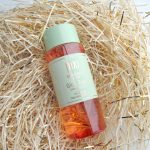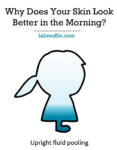Move over UV and sunscreen, the next big thing in anti-aging is pollution and pollution prevention. Many types of pollution are well known to be harmful when inhaled, but there hasn’t been much information about how they interact with skin until quite recently. A handful of newer studies have shown that pollution is linked to skin allergies, aging and slower recovery from damage.

How Does Pollution Impact Your Skin?
Different types of pollution cause different varieties of skin damage, but the two most important ones are:
- Oxidative stress: Pollution causes the production of highly reactive free radicals, which cause all sorts of non-specific damage to the biological structures in your skin. They’re like hyperactive bulls in a china shop. The increase in free radicals leads to the activation of matrix metalloproteinase enzymes which break down collagen in the skin. It also sets off inflammatory cascades that can slow down collagen formation and decrease the amount of fat underlying the skin, causing wrinkling. Check out this article for more on oxidative stress and antioxidants.
- Activation of arylhydrocarbon receptors (AhR): Activation of AhRs on skin cells is linked to inflammation and pigmentation. There’s also evidence that it causes the activation of MMP-1, a matrix metalloproteinase.
Different Types of Pollution
The types of pollution that are most relevant to skin aging are:
Particulate matter (PM)
The particulate matter (PM) that’s relevant in skin health is small pieces of soot, and is usually produced from combustion of fossil fuels such as the burning of petrol in car engines. Technically though, any small solid particles are included in particulate matter.
Particulate matter is usually classified according to the size of the particles. PM10 includes coarser particles 2.5 to 10 microns in diameter and come from dust and industrial emissions, while smaller PM2.5 particles are less than 2.5 microns across and usually come from fires, power plants and motor vehicle exhaust. (For reference, the thinnest human hair is about 17 microns across.)
Because of their large surface area, particulate matter is good at reacting with skin and causing oxidative stress. Because of their small size, they can penetrate into cells and produce oxidative stress in mitochrondria. One of the other concerns about particulate matter is that other pollutants, like polyaromatic hydrocarbons (PAHs), can latch onto them, which means they’re a very efficient means of delivering large amounts of pollutants to your skin. PAHs can activate the AhR pathway, so particulate matter can age skin in that way as well.
In a few studies, exposure to particulate matter was linked to formation of wrinkles and pigment spots – in one study, increased exposure to particulate pollution was correlated to a 20% increase in pigmented spots on the cheeks and forehead. There’s also evidence that particulate pollution can exacerbate atopic dermatitis, psoriasis, acne and skin cancers.
Ozone (O3)
Ozone is an oxidant that’s produced when other pollutants (primarily from cars) react in sunlight, in a phenomenon known as photochemical smog. It’s particularly bad around high-traffic areas in summer, and can cause asthma attacks. When ozone interacts with skin, it depletes its natural antioxidant stores (particularly vitamins E and C), which leaves it more susceptible to free radical damage and oxidative stress. It also damages proteins and lipids in your skin.
Ozone exposure has been linked to increased MMP-9, a collagen-degrading enzyme, in animal studies. Ozone can also activate AhR in skin, which could lead to inflammation and pigmentation.
Nitrogen Dioxide (NO2)
Nitrogen dioxide is a brown, acrid-smelling gas produced by motor vehicles and power plants. There hasn’t been as much research performed on NO2‘s impact on the skin, but it’s been correlated with increased pigment spots.
How to Protect Your Skin From Pollution
What can you do to protect your skin from pollution, aside from run away to a mountaintop and live in hermitude for the rest of your life? Luckily a lot of products you already own will probably protect your skin from pollution, although you’ll see their anti-pollution benefits emphasised more and more.
Antioxidants
One way to protect your skin against oxidative stress is to apply antioxidant products. Antioxidants like vitamin C, N-acetylcysteine and green tea polyphenols can decrease the response to ozone in vitro, and a very recent study found that vitamin C serums reduced some of the aging responses to ozone in human forearm skin.
Barrier protection
Many trending skincare ingredients are designed to form a shield between your skin and pollutants, such as Pollushield and Exo-P. There seems to be a lot of variety with the ingredients that can potentially do this, which is unsurprising, since a lot of ingredients can form sticky gooey films on your skin. Since pollution protection is so new, none of these have peer-reviewed studies to support them yet as far as I know, but some are supported by manufacturer studies. I’ve been trying out Synergie Skin Enviroshield spray, which contains Exo-P (Alteromonas ferment) as its pollution shield, as well as Elix-IR (Polygonum aviculare extract) to protect against UV and IR as well.

Thorough but gentle cleanser
You’ll want to thoroughly clean any accumulated pollution off your skin at the end of the day, but if you clean too thoroughly, you risk impairing your skin’s protective ability. Dermalogica’s Daily Superfoliant (reviewed here) is designed with this approach in mind. For more on gentle cleanser, read up on picking gentle cleansers and some of my recommendations.
AhR antagonists
An interesting new way of protecting against pollution damage is by using molecules that can block AhR activation. A formula containing 0.5% of an AhR antagonist BDDI was found to reduce activation of genes related to aging in a clinical study.
Verdict
UV is still the number 1 environmental ager, so if you haven’t sorted out your sun protection, I wouldn’t even bother thinking about pollution. But if you’re protecting yourself from UV and you want more, and you’re exposed to high pollution urban environments, then anti-pollution is a good place to look next!
References
SE Mancebo & SQ Wang, Recognizing the impact of ambient air pollution on skin health, J Eur Acad Dermatol Venereol 2015, 29, 2326-2332.
A Vierkötter, T Schikowski, U Ranft, D Sugiri, M Matsui, U Krämer & J Krutmann, Airborne particle exposure and extrinsic skin aging (open access), J Invest Dermatol 2010, 130, 2719-2726.
A Vierkötter & J Krutmann, Environmental influences on skin aging and ethnic-specific manifestations (open access), Dermatoendocrinol 2012, 4, 227-231.
The products mentioned in this post were provided for editorial consideration, which did not affect my opinion. This post also contains affiliate links – if you decide to click through and support Lab Muffin financially (at no extra cost to you), thank you! For more information, see Disclosure Policy.






Thanks for a great post on pollution and link to skin damage. Didn’t know there were many types of pollution that causes not just wrinkles but pigmentation ?? Your writing is always so informative !
Thank you so much! ^_^
Hey!! Love your blog..
Please do a review on wait loss supplements like fitafinitty and women’s best
I’m a bit hesitant to go into nutrition since the studies are a lot harder to interpret than for skincare! But from what I’ve read, the weight loss supplement with the best evidence is the ECA stack (ephedrine/caffeine/aspirin), which is unfortunately not available in Australia since ephedrine is banned.
This site is good for looking at supplements: https://examine.com/supplements/eca/
Do oils (marula, sea buckthorn, argan, rosehip, etc) work as good antioxidants/barriers to protect from pollution damage?
Not really in my opinion. They have small amounts of antioxidants, but they’re not very good barriers (they sink into the skin too easily).
Thank you for sharing this. Very informative and educational. It’s very well researched too.
Where in your routine do you apply the Synergie Skin Enviroshield—before or after sunscreen?
I use it after – I’m not sure what the “official” answer is though!
Hi,
I agree with you. When I am out and about, you can just imagine how dirty my face can be because of air pollution. I bring face wipes with me all the time but rubbing your face often, can make your skin dry. I need that Enviro spray, thanks for sharing!
I’ve read somewhere that simply applying moisturizer and foundation is enough to shield against environmental pollution because it creates a barrier for your skin. Is this true?
P.S. I love your blog so, so much!!!
I feel like it should be, and looking at the ingredient info for barrier products it sounds like it is, but I wish there was more unbiased third party research on this!
And thank you 😀
Hi Michelle,
Thanks for these useful tips. Looking forward to the more informative post. I simply use makeup and other natural products to shield skin against pollution. And I always make sure to remove makeup and wash face before going to bed.